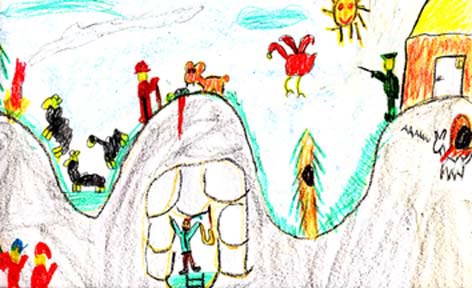 Figure 1
Figure 1
The "Green School" as an Aesthetic, Ecological and Moral Folk Experience in Poland
by
Mary Stokrocki, Arizona State University
with
Mariusz Samoraj, University of Warsaw
Published (2003) in Journal of Cultural Research in Art Education, 21, 44-59.
Also Publised"An Ethnographic Exploration of Children's Drawings of their First Communion in Poland," International Journal of Education & the Arts (Online). Available online at http://ijea.asu.edu/v3n6(Mary Stokrocki & Mariusz Samoraj, Poland).
 Figure 1
Figure 1
Abstract
This phenomenological study is a search for the essence of the Polish Green School. I explain the "Green School," examine its rationale and scope, and overview the history of Poland's environmental exploitation. Then I present a week experience in one such school and examine children's reflective drawings. I include, not bracket, my own experience in footnotes as I search for my grandmother's roots. The program consists of a highlander folk music demonstration, several hikes, a hunt to find beauty in nature, and in contrast, a trip to Auschwitz. Children's reflective drawings were mainly mountainscapes that contained a secret cave, human figures, especially the highlander blowing his horn, some animals, and stylized trees; colored with variations of green. Children can learn to become aware, preserve, to live in peace, and to share. The essence of this aesthetic phenomenon is historical, perceptual, cognitive, moral, and ecopolitical. Without "the green," the spirit can't survive.
Introduction
Research on ecological experiences based on the arts for elementary school children in Poland and the USA is scarce. A review of 50 ERIC articles revealed mostly curriculum and activities dedicated to concern for endangered species and extinct animals. Some art educators recently described results of an ecological program that deal with a neighborhood wetlands preserve (Birt, Krug, and Sheridan; 1997) and a water river environment in California (Anderson, 2000). Ecology is "concerned with relationships among living organisms and their surroundings, including human societies and their geographical environments" (Lankford, 1997, p. 49). Lankford calls for ecological stewardship which involves 1) a pledge to promote ideals of right over wrong; 2) recognition that a person's actions concern societal and environmental wellness; and 3) all choices and behaviors must respect people and their habitats.
The purpose of this study is to search for the essence of the "Green School." I first present the rational and scope of "the Green School," its instructional goals, a history of Poland's environmental problems, then document a "Green School" experience . I follow with a description of how the children react to the experience through informal interview and their reflective drawings. Finally, I compare the "Green School" to programs in the United States and summarize its essential qualities. I discuss these questions, What is the Green School? Why is it based on aesthetic education? What are Poland's environmental problems? What is the Green School Experience? How do children react to the Green School? What can we learn from the Green School experience?
What is the "Green School?" The Poles are determined to protect their environment. The Polish environmental movement (the National Conservation League and the Polski Klub Ekologiiczy) started in the late 1970's in Krakow. Since 1989, it forced the closure of the Skawina aluminum plant that dumped its chemicals into Polish rivers (Salter, 1999). This newly formed Green Solidarity Party started a national campaign to publicize ecological problems and to help solve them. Education programs, both televised and experimental, such as "the Green Schools," followed.
What is its rationale, instructional goals, and scope? The Polish government then decided to institute "Green Schools" to educate its young people about their culture and its ecological problems and to instill pride in Polish heritage. . Many foreigners have settled in Poland: Rumanians, Basques from Spain, Bavarians, Swiss, and Germans. After its revolutionary and economic phase, Poland has now entered a period of cultural change through mass aesthetic and ecological education. Its instructional goals are to enhance ecological, and cultural change in Poland through aesthetic education
Children around Poland now attend different ecological "Green Schools," zielonych szkol, for approximately a week, throughout the month of May. Mariusz Samoraj, Doctor of Humanistic Studies at the University of Warsaw, has taken children to experience different "Green School" sites around the country for eight years. He also runs a summer scouting program to protect cultural sites. He is deeply concerned with protecting the folk aspects and traditional values of the family in Poland. Mariusz explains, "Traditional values bring you to humanity and thus the need for aesthetic education" (Personal Interview, 6/5/00).
Why is it based on aesthetic education? Mariusz stated, "The aim of aesthetic education is to breed an understanding of life and other people through art." Students also learn tolerance of other cultures and communities even within Poland. "Thus, the purpose of aesthetic education is to shape cultural participation; it requires an early and systematic initiation of children into the sphere of artistic values, which, in turn, defines the school's basic responsibilities" as well as developing their participation in culture (Wojnar, 1978, p. 45). Such a model begins with young elementary children and requires their engagement in expressive and interdisciplinary activities, such as art and music and science. The continuation of Polish culture depends on "the intensification of a community of felt experiences" (Wojnar, 1978, p. 52). Aesthetic education strives to educate "multisensual cognition and visual perception, encourage emotional expression through different techniques and media, and stimulate creative thinking" (UNESCO/InSEA, 1999, p. 2). Creativity in Poland generally is seen as "an open and sensitive attitude, a state of mind... including active participation, social behavior, and play" (Wojnar, 1995, p. 137). Children are free to express their own ideas and control their activities. This freedom to think and do is important for a country trying to discard the shackles of Communism, dependence on the state, or even a teacher. Aesthetic education is a condition for greater dialogue and understanding. With such experiences, as the Green School, children can share and reflect on their choices.
What are Poland's environmental problems? Poland has a history of being exploited by other countries: Mongol Tartars until 1242, German Teutonic Knights from 1260-1410, Ottoman Turks until 1673, and 700 years of offensives and political intervention from the Muscovite Tsars (Russia). The Swedish Deluge (1655) reduced the population by half and destroyed nearly all of Warsaw. Followed by the partitioning of the country three times, Poland was abolished as a country in 1797. With Napoleon's rise and attempt to capture Moscow, Polonian liberators joined his forces and died. The resulting Congress of Vienna (1814-15) left only Krakow as a "symbolic city state" (Salter, 1999, p. 597). Poland for several decades was a buffer state between Germany, Russia and Austria. The Poles revolted several times; this resulted in a reign of Russian repression. With World War I and after a few years of fighting and diplomacy activity, Poland arose in 1918 with self-governance. But with Stalin on the east border and Hitler on the west, Poland was in trouble. When Hitler invaded Poland in 1939, millions of Polish civilians, including virtually every Jew, were slaughtered in Nazi concentration camps. This further included the massacre of Katyn in which 4500 Polish officers were shot" (Salter, 1999, p. 599). Of all countries in Nazi Europe, Poland suffered the most, with a quarter of its population dead, the country in ruins, reduced in size and its borders shifted to the west. With Soviet victories at Stalingrad, the Poles were subsumed under Russia's influence once more. The Russians hauled away several hundred Poles in eastern provinces to forcefully work in Siberia. In my own family, my great uncle was beaten and nearly starved to death in a freezing Siberian camp and my great grandmother died in attempting to escape. This last Russian occupation left behind in Poland unrestrained industrialization that caused much environmental pollution both in air and water wastes (Correspondence with Mariusz Samoraj, 11/16/00).
Poland further suffered environmentally from various environmental abuses. Before the 18th century, people cut and burned trees for fuel and the forests were almost ruined. The Silesian King Stanislaw-August Poniatowski forbade such waste and only certain trees were used for charcoal (Salter,1999, p. 613. The ancient oak trees of 800 years were nearly obliterated. The newer pine forests are only about 200 years old. In the 20th century, Communist regimes, for over 40 years (1950-1990), exploited many of Poland's natural resources such as iron, coal, and mined and smelted zinc and lead ores. Atmospheric conditions in southwest Poland resulted in the huge polluted area, known as "the Black Triangle." This starts in Northern Bohemia in the Czech Republic and extends to Saxony in eastern Germany and ends in Katowice in Poland. "The pollution is a combination of sulfur dioxide, nitrogen oxides, dust and particulate, and smog and ozone" (Salter, 1999, p. 614). Such devastation has led to shortened life expectancy and congenital defects.
In 1990, a government report discovered that contaminated river water corroded industrial equipment (Curtis, 1994). Industrial pollution made more than 80% of the rivers nonconsumable, especially the Vistula (Wiesla). Even rural health was threatened because of the lack of sewage rules and the countryside was littered "with thousands of untreated and unregulated dumps" (Salter, 1999, p. 615). Many power stations in north and south Poland burnt brown and black coal. Industries also dumped chemicals into the rivers. Thus, the lakes and rivers were still dirty and unhealthy. Another result is the enormous loss of jobs and the rise of coal and auto pollution and non-recyclable goods.
An Example of the Green School Experience
This year, the Creativity Activity School in Warsaw, in which I was observing, conducted a "Green School" in the city of Wisla--the Pearl of the Beskid Mountains. The experience lasted for three days with two extra days for traveling back and forth (May 22-25, 2000). The city is at the source of the Vistula River, the longest in Poland and about 400-600 miles above sea level. The trip from Warsaw took about six hours and the children arrived late in the afternoon in the pouring rain. The site is famous for its winter and summer sports. We stayed in a grand hotel, called Sosna, where children and teachers shared small rooms and a balcony overlooking the picturesque greenery.
That night the fog rolled over the mountainside; the rain dropped heavily to the ground; the breezes blew through the windows; the Green surrounded all. Brown smoke puffed from the chimney; dampness crept in the windows; and the church bells rang on the hour. Birds chirped in delight and the cock crowed. Rest for awhile. Evening meal was light and consisted of soft white cheese, bread, ham, chocolate bars, and hot tea.
Highlander folk dress and music. Approximately 100 students participated in the "Green School" this year. While the older students (45 students from sixth to eight grade) went for a hike in the morning, the younger ones (about 55, K-5 children) met the highlander, "Joseph the Beard" in a large salon. He shared his handmade instruments and natural sounds. He then invited children to try on his wool cape and hat. He said, "See how warm and soft it feels." Joseph also told them that the hat and cape (pyramidal) were "like a roof" to cover his head and body from rain. His vest was also colorfully embroidered.
Joseph then shared his wooden and bone instruments. He blew on them to create a variety of sounds. He pulled a special leaf out of a jar of water and blew a song on it. "The edge of the leaf was like a string," he explained. The children sat entranced. Next, he passed out instruments for children to try. Then he told the children to close their eyes and imagine the old times when women kept the fire and carried it from place to place. He told them not to take pictures with a camera but "to take them with their mind, to use their memory, and to concentrate on the lights, sounds, smells, and small details."
He asked a child to come and hold his stomach and count how many times he breathed. He blew on a straw flute such sweet sounds. The child answered, "Five times." "Very good," he praised. He further instructed, "It is very difficult to play. You must use your throat, the front and back, and stomach." Then he made music with his nose and lips to which the children were greatly amused. He also played a tiny string instrument. Later, he brought out other instruments for children to explore, such as different sized metal bells, a cowbell, and a 24" trombone.
Joseph asked the children again to close their eyes and to say a prayer. He started a folk song, "I am, I can, I share what is good" in which children clapped their legs, their hands, and then their partner's hands in rounds of three. He led the group in a circle dance from left to right repeating the same rhyme. Joseph was so happy that he kissed the children on their heads!
When asked what they learned, younger children mentioned unique and natural instruments, such as the leaf. Older students said that Joseph was "a good and spiritual man." He told them "to preserve the land, to know and touch each other, to use their hand [shake] not their fist." The highlander culture is a mixture of country cultural behaviors that many city and suburban children no longer experience. Mariusz commented on the importance of such aesthetic and value education through art. He reflected, "We need to protect the symbols of nature and the things that we value. The performance was a mixture of theater, dance and therapy."
Trip to the mountain. In the afternoon, even though the rain still drizzled, Mariusz took the children hiking up a steep mountain trail [1000 K] to the top of the Beskid Mountain in southwestern Poland. At the trailhead stood a cross. Many crosses and shrines stand along mountain trails and highways in Poland. The six-year-olds eagerly climbed the difficult ascent in single file. The grass and mud soaked their feet. A variety of bird sounds echoed in the woods, while leaves rustled gently in the wind. The sun began to peek through the clouds. Children jumped from one ridge to another as they circled around large puddles and fallen trees. Tiny flies buzzed around their heads, pine smells filled the crisp air, and resin oozed from the trees. Perceptions deepened.
At the top, children stopped to rest, eat a snack, and look at the vista. The blues progressively diminished into endless mountains. This rain was a blessing after three years of drought. The wheat was short and the potatoes were lean this year.
Next, the teachers took the children to see an underground cave that was too steep to climb down into. Each child peeked inside as two teachers held them. While some children looked, others climbed around large extracted tree roots.
The history teacher then gave a lesson about their Polish ancestors, the Slavic Rumanians. He narrated, "They were shepherds who came through the mountains. They planted potatoes and cabbage and made cheese from goat milk." He explained that some of the pine trees were over 200 years old, so the foresters planted diverse trees for the future. Then he pointed out two sources of the Vistula River -- the black water that is comprised of slow moving streams and the white water that mainly contained rapids. Later, we stopped by a dam, and he explained its purpose to protect the towns below from the vicious floods, provide energy, and form a lake for sports recreation. The strenuous hike lasted almost three hours in the afternoon.
Auschwitz. A part of this "Green School" experience was a trip to Auschwitz, the largest Nazi Concentration Camp in Europe. The Nazis founded it originally to house Polish political prisoners (Smolen, 1999). The rationale was to expose students to the realities about what happened, the scope of the holocaust victims, and the possibility that this devastation could happen again. Although the younger children did not experience this event, the older students had no idea about the holocaust at all, why these people were killed, and that the doctors abused them. The older students solemnly walked throughout the stone buildings for two hours. They were serious, asked few questions, and were exhausted at the end. Later, they mentioned the place as "terrible, all the wasted bags, shoes and even human hair" [woven in cloth and stuffed in bedding]. They felt the place was cold, rough, and dull. They were saddened to hear that the Nazis killed so many people (approximately 1.5 million victims) from many backgrounds -- Poles, Gypsies, French, Slavs, Rumanians, Belgians, Dutch, Norwegians and Lithuanians, but mostly Jews. Such an extreme experience is a step toward ethical as well as cultural education. The truth of the holocaust is that it is ever new. Investigators keep on finding new aspects about it, and that every culture should be on watchful of future genocide (Presentation made by Dr. Fred Greenspan, Holocaust Expert and Professor and Chair of Dept of Religion at the University of Denver, 2/2/2000). This study does not deal with this concept, but every country should provide holocaust education to teach empathy and responsibility (Nahmmacher, 1997).
Find something beautiful. The next day, the weather was gorgeous! The sun peeked through the pines and the air was fresh with pine odors. The grass glistened and birds chirped madly as we hiked through the meadow. Life felt so renewed. Mariusz asked the young children to find something beautiful in the forest. Children discovered assorted wood with shapes resembling familiar things. Six-year-old Magda found a bark piece that she called "a boar" and Martin held up his stick-shaped deer. Angies discovered a real snail and four girls shared a tiny ladybug, a sign of good luck. Children enjoyed this treasure hunt. Aesthetic training starts with natural curiosities.
At the top of the hill, the groups stopped for sandwiches and drinks. Girls blew dandelion spores and picked bouquets of wild flowers, including buttercups, daisies, and forget-me-nots from the field. Two teachers showed children how to weave a daisy chain and one teacher laid a crown of daisies on a girl's golden hair. All of nature seemed to gleam with beauty.
Upon the return, Mariusz pointed to the sap dripping from the pine. Then he demonstrated how to hug a tree, listen to its life, and absorb its energy. Throughout the hike back to the bus, children stopped to caress trees. Such beautiful memories are to be treasured.
How Did Children React to the Green School?
Mariusz then invited all of the children to draw their experience at the "Green School." Mariusz reviewed what they learned. He said, "Remember what Joseph taught you about different instruments, songs, and dance. We were lying in the meadow and looking at the beautiful view. Show him playing his flute near his village hut." Mariusz mimicked the various flute and natural sounds: chirping, cawing, and whistling. The group sang a round and slapped their hands together (10-minute motivation).
This section reveals insights on "what" children draw and interprets what they "learned." We concentrate on the six-year-olds' drawings. The analysis includes the children's dominant type of drawing, how they started, their featured attractions, and other subject matter. Notes on learning include "how" children configured the schema and space relations. Since this study is primarily interpretive and generative (of themes and concepts), the use of statistics was not important. Numbers are simply indicated by the numerical format (e.g., 15/20).
Mountainscapes dominant. In the first grade class of 20 students, for example, most students (15/20) started their drawings with mountain base lines (Figure 1). Ania, for instance, first drew a large pyramid-shaped mountain outline with an inner line parallel to it. She colored the area, in between, brown. She then added two hill lines: one to the right and another to the left. Next came repetitive triangle-shaped tree forms, one on top of the other, at different levels on the left hill. She added a smiling sun. Boys also began with large zigzag lines to represent mountains, such as Max's drawing. Other students made a wavy hill line across the page. Only two students used a simple baseline or the bottom of the page. The trip to the mountains inspired these young students to use multiple base lines and to overlap forms, which is unusual for children in the schematic stage of development (Lowenfeld & Brittain, 1987).
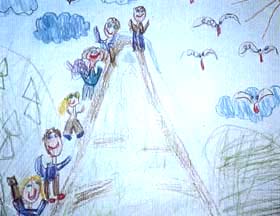 Figure 2
Figure 2
The underground cave. The cave fascinated the young children and some (5/20) depicted it. Even though this space schema is not frequent, the concept seems advanced for sixth graders to depict without any two-dimensional model. Magda, for instance, worked slowly and carefully. She drew a baseline on the left side in the middle of the page. Then she added a box area, which she called "a cave" on the right and colored it gray with a red ladder overlapping it (Figure 3). When I asked her where cave was, she remarked, "underground." She drew a figure to the right and said it was her uncle Marek, who was one of the teachers who supported children while they looked into the cave. At the end, she drew the sun, and filled in her sky area using the blue color. For his cave, Przemek made a rounded box outline in the middle of his paper and a "U-shape" at the bottom of it. He lined up round boulders on all sides, except at the bottom in which he drew a short ladder going straight down.
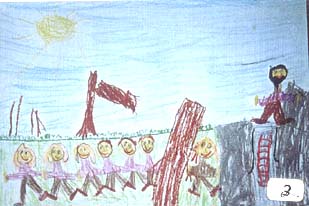 Figure 3
Figure 3
The highlander. Half of the children depicted the highlander (10/20). In each drawing, the children featured him with his beard and hat with his arms up and blowing a horn (Figure 2). The horn was exaggerated to show its importance as a herald of calling people home. In contrast, children depicted other people in a simple repetitive fashion (14/20). Magda, for example, sketched people in a row, outlined eight faces, filled them in with a flesh color, overlapped smiling faces, then added yellow halo hair to represent girls and short brown arched hairdos to show boys (Figure 2). The tendency to depict ordinary people in a row with recurrent shapes occurred in three drawings.
Musical instruments. Various wind instruments were depicted (9/20). Jendrek called his instrument a trombita, a six-foot trumpet that usually needs support (Figure 4). Both Max and Przemek show curved horns. Luka presented one figure blowing his horn in the front and a smaller one, in the distance. Mainly, the boys depicted these instruments.
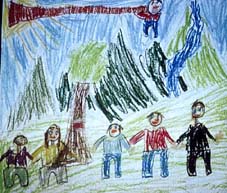 Figure 4
Figure 4
Animal schema. Animal drawings (8/20) included four-legged creatures, birds, and insects. Unusual was Przemek's drawing of animals. From left to right, he included a wolf, three sheep, bear, a stork, and a donkey in three-quarter view (Figure 1). Some drew the typical "M-shaped" birds, but Ania added rounded eyes, orange beaks, and feathers and called them storks. Storks are becoming extinct birds but are favored in Poland because they are fertility symbols. Ania added a butterfly with a dotted pattern (Figure 2). Polish children seem to have a deep affection for animals that stems from some folk culture rituals, such as making such ritual flour-dough animals as goats, bears, hares during New Years Eve and Twelfth Night (Ogrodowska, 1997).
Stylized trees and patterns. Children developed unique tree patterns. Max drew some overlapping zigzag designs along rectangular tree trunks (Figure 2). Mary used stacking triangle tree schema and alternated large and small trees in a row (Figure 5).
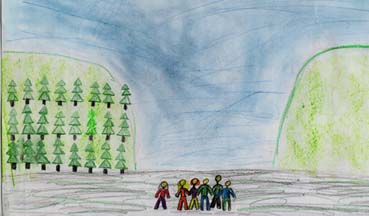 Figure 5
Figure 5
On the left hill, she made a delicate pattern of pine trees that consisted of three stacked triangles in colored pencils. A team of boys made a remarkable aerial view drawing of extracted tree roots (Figure 6). Direct experience heightened their awareness of a variety of tree forms that included mixtures of aerial and elevation views, typical of the dawning realism stage (Lowenfeld & Brittain, 1987).
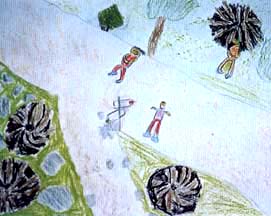 Figure 6
Figure 6
Reflective drawings and realistic concerns. Throughout my observations, Mariusz asked children to "build a story," He would inspire with questions: What happened? Can you fill the empty space? Explain where it is? Is it a meadow or a mountain picture? He wanted the children to include more details in the background. At the end of the drawing session, Mariusz invited children to come to the front of the room and talk about their drawings. He directed them to choose the best and tell the reasons. Most of the answers were realistic concerns. For example, Ania (6-year-old) chose the figures that were drawn carefully and said, "you can tell what was going on." Agnieska selected a picture where the grass was drawn well. These girls just discovered by themselves the crayon resist technique--that water and crayon do not mix. Mariusz pointed out the pictures that told the best stories, such as one that depicted two figures that hiked to the top of a tall triangular mountain with Polish flags. I soon discovered that painting with crayons had a deeper dimension--story-telling.
Older Children and Auschwitz. I asked the older children to draw their experience of the "Green School" and Auschwitz as well. Only two older boys drew the arched entrance at Auschwitz with its deceitful promise "Work Hard and Be Free." Mihal, for instance, drew an intricate series of parallel lines with hooks to represent barbed wire and a swastika for a sun (Figure 7). Another boy outlined his prison camp in gray and black. Eight other students drew typical scenery (Figure 8, top drawing). Two girls drew the carnival rides (Luna Park). They said that they didn't remember images and avoided the Auschwitz subject. This memory block may be a typical survival device in Poland and even in America for those people, who wanted to assimilate and to forget their former sad experiences.
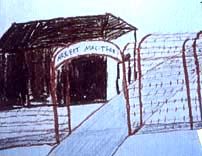 Figure 7
Figure 7
Conclusions:
What Can We Learn From the Green School Experience?
This aesthetic phenomenon taught the children many things--historical, perceptual, representational, cognitive, moral, and ecopolitical. Historically, the children learned to appreciate their highlander culture with its dedication to nature. Such devotion was widespread among the Slavs, who were the Polish people's first recorded ancestors. They worshipped holly trees, water, and mountains. Such attachment to nature lives on in family love of picnics and gardens. People in the city still keep small public gardens for fresh vegetables, beautiful flowers, and peaceful places to think.
Perceptually, the cold and rain heightens the sensory experience of hiking for city and suburban children. The rainy drizzle and sunny dry spells, musty grass smells, various bird calls, lights and shades of light that beam on the greenery, rough textured woods, sticky tree resin, and the physical strain of walking will impress deep perceptual memories. Even the activity of finding one natural beautiful thing and sharing its reason is an inspirational aesthetic moment. More experience with local crafts and textiles will add textural discrimination.
Cognitively, asking children to reflect both visually and verbally on their experience can strengthen cultural knowledge. They can learn about regional folk arts-its music, dance, and visual art forms. In their drawings, the dominantly depicted character is the folk highlander with some type of exaggerated horn to denote his significance. Children drew a variety of wind instruments: the large trombone, a flute, and ram's horn in their pictures, but only one instrument per picture. Later, I met several children who purchased wooden flutes in the local tourist shop. Clearly, the highlander and his natural instruments comprised the children's most memorable experience. Reflection entails thinking about the art making process and content. "The ability to reflect on one's goals, decisions, and solutions, as well as about the influences of the works of others on one's own work, seems to be crucial to cultivate in the service of any artistic endeavor" (Rosenblatt & Winner, 1989, p. 10). New spatial relationships and natural forms, such as high mountains, underground caves and tree roots, fascinate children. Cognition begins with such perceptual awareness as seen in their use of multiple baselines, which is advanced for their developmental stage (Lowenfeld & Brittain, 1987).
They also learn interdisciplinary connections, such as the purpose of dams in science, music making with natural reeds, and clothes made from sheep wool. These are characteristics of the regional folk ecology. Thus, "a synthesis of personal expression and contemplative experience" may occur (Wojnar. 1978, p. 46). The "Green School" adds personal and group reflective activities to intensify understanding of "aspects of the world that might go unnoticed" (Wojnar, 1978, p. 47).
Morally, lessons from Auschwitz teach us never to allow this terrible hatred and persecution to happen again. Children internationally need to be taught "coexistence not only with nature, but also with other people" (Wieczorek, 1999). Aside from this, teachers are concerned about parents who are too busy to share cultural experiences with their children. In many homes, parents were missing because Poland's poor economy demanded that both parents had to work. He felt that this was a national problem because materialism was important now.
Ecologically, the Pickering Elementary School in Ohio similarly aimed to assist the school community in discovering the natural beauty within their own neighborhood wetlands preserve (Birt, Krug, and Sheridan, 1997. The environmentalist also showed the children "how to whistle with a wide blade of wetland grass" and later asked the children to draw "the singing grass"(p. 9). The Ohio project culminated in a ceramic mural that stands in the wetlands and includes students' ideas about their wetland experience. Krug believes that "art, culture, and nature can be investigated using cyclical inquiry processes that draw from direct experiences, observation and reflection, critical thinking, and collaborative action (Britt et al, p. 9). Anderson (2000) describes another recent program at the elementary level where students experience and sketch a river environment in Central California. The central issue is to conserve water in the West and children have the power to make a difference. Anderson (2000) offers several extensions for ecological teaching. The program in Poland can benefit from activities that "identify, study, and solve real-life problems" in their own back yards (Britt et al, p. 10). Children learn that they can preserve (not waste), share, and that they must be aware.
Ecopolitically, this ecological awareness stems deeper as children learn to stay alert to political problems. Nothing is more desperate than being deprived of "the green-freedom." The color green pervaded the children's mountain experience and in their drawings. The older children learned that the opposite of beauty and green is gray and destruction. The heightened experience of the horrors of Auschwitz in contrast aesthetically marks their memory forever. Greenpeace has christened Poland as the Green Tiger of Europe as it strives to preserve its indigenous cultures, clean up its ecology, maintain its independence, and preserve its peace (Salter, 1999, p. 34). "We should not forget the destruction. Now we need to rebuild and teach the children. The arts can help us remember" (Conversation with Edith King, Professor of Educational Sociology at University of Denver, October 10, 2000). Without "the green," also the symbol of fertility and hope, the spirit can't survive.
** Thanks to Mariusz Samoraj, the children and teachers at the Szkola Aktywnosci Tworczej; my cultural advisors Jerzy, Elzbieta, Anna & Piotr Prajsnar; Katryna Koziol; and Anna Kindler, Professor of Art at University of British Columbia,
Credits: Mary Stokrocki is Professor of Art Education at Arizona State University and a InSEA World Councilor. Mariusz Samoraj is Professor of Humanistic Studies at Warsaw University. He is writing a book on the Green School Movement in Poland
References
Anderson, H. (2000). A river runs through it: Art education and a river environment. Art Education, 53(6), 13-17.
Birt, D., Krug, D., & Sheridan, M. (1997). Earthly matters: Learning occurs when you hear the grass sing. Art Education, 50(6), 6-13.
Bruyn, S. (1966). The human perspective in sociology: The methodology of participant observation. Englewood Cliffs, NJ: Prentice-Hall.
Creswell, J. (1998). Qualitative inquiry and research design: Choosing among five traditions. Thousand Oaks, CA: Sage.
Curtis, G. (Ed.). (1994). Poland: A country study (3rd ed.). Federal Research Division, Library of Congress. Washington D.C.: Superintendent of Documents.
Husserl, E. (1931). Ideas: General introduction to pure phenomenology (D. Carr, Trans.). Evanston, IL: Northwestern University Press.
Lankford, L. (1997). Ecological stewardship in art education. Art Education, 50(6), 47-53.
Lowenfeld, V., & Brittain, W. L. (1987). Creative and mental growth (8th ed.). NY: Macmillan.
Merleau-Ponty, M. (1962). Phenomenology of perception (C. Smith, Trans.). London: Routledge & Kegan Paul.
Moustakas, C. (1994). Phenomenological research methods. Thousand Oaks, CA: Sage.
Nahmmacher, R. (1997). Ethics in the face of Auschwitz: The emotional and pedagogical responsibility of holocaust remembrance. Dissertation Abstracts International, 58(03A), 855. (University Microfilms No, AAI9728614)
Ogrodowska, B. (1997). Polish rituals of the annual cycle (Trans. by K. Jaskulska-Wegierek). Warsaw, PL: State Ethnographic Museum.
Rosenblatt, E., & Winner, E. (1989). Children's drawings, In H. Gardner & d. Perkins (Eds.). Art, mind and education . Chicago: University of Illinois Press.
Salter, M. (1999). Poland: The rough guide. New York: Penguin.
Spiegelberg, H. (1982). The phenomenological movement (3rd ed.). The Hague. Netherlands: Martinus Nijhoff.
Stokrocki, M., & Samoraj, M. (2000). An exploratory study of ceramic activities in a Polish elementary school. Unpublished manuscript.
Stokrocki, M. (1997). Qualitative forms of research methods. In S. La Pierre & E. Zimmerman (Eds.), Research methods and methodologies (pp. 33-56). Reston, VA: NAEA.
UNESCO/InSEA. (1999) Poland: National Profile. Idea: The International Directory of Resources for Education in the Arts. Available online at http://cspace.unb.ca/idea/countries/poland/profile.html.
Wieczorek, T. (1999). The green valley [artistic workshops]. Host name: UNESCO/InSEA. Available on-line: http://cspace.unb.ca/idea/countries/poland/poland09r.html.
Wojnar, I. (1978). Theory of aesthetic education: A Polish perspective. Journal of Aesthetic Education, 12(2), 41-54.
Figures
1. Most students started drawing mountain base lines and mountain scenes predominated.
2. Fascinated by the cave they visited, Magda drew a cave on the right, below the baseline, and colored it gray with a red ladder overlapping it.
3. Half of the children drew the highlander with his horn. In this case, the horn was exaggerated to show its importance as a herald of calling people home.
4. Some children drew people and trees perpendicular to the diagonal baselines. Unusual was the anchoring of an arched rain area perpendicular to the mountain's slanting base.
5. Polish children are fond of drawing animals. Przemek included a wolf, three sheep, bear, a stork, and a donkey in three-quarter view in his picture.
6. A team of boys made a remarkable aerial view drawing of the fallen tree roots in brown and black.
7. Mary mixed her media for a rainy atmospheric effect.
8. Most older students featured scenery (top drawing) but two boys drew the arched entrance at Auschwitz with its deceitful promise "Work Hard and Be Free."